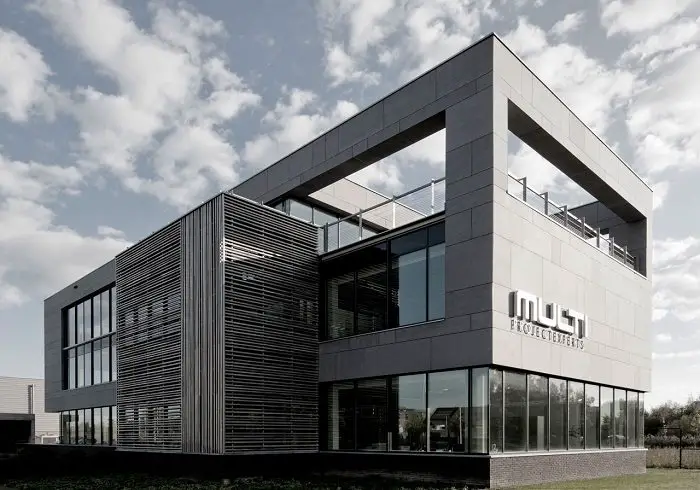When Ludwig Hatscheck invented fibre cement in the late 19th century, he combined the basic elements of the earth: mineral materials, water, air and fire (heat) in a simple filtration process. He named the resulting materia “Eternit”, hinting at the superior durability of this new material.
The company’s mother company, Etex, has been manufacturing fibre cement materials since 1905. The most prestigious incarnation in this proud heritage of unique materials is the EQUITONE® facade material range. The Hatscheck production process makes each EQUITONE facade panel unique with an individual fibre cement texture.
Most EQUITONE facade materials are not treated with artificial colour coatings, giving the equitoned, or through-coloured, materials a raw, unfinished character. In the 1950s leading architects such as Walter Gropius pioneered the use of coated fibre cement panels using the ventilated facade (rainscreen) system. Designer Willy Guhl created the famous “loop chair” from 1 piece of fibre cement in 1954. This design still bears witness to the core qualities of the fibre cement base material: thin, light yet indestructible and beautiful.
In 1987, Herzog & De Meuron designed the Ricola storage building in Laufen using uncoated fibre cement panels. The resulting shutter facade, which is a reference to the cardboard boxes inside, inspired Etex to start the industrial development of raw untreated fibre cement materials. Today, EQUITONE has a full range of through-colored, untreated fibre cement materials. Leading architects of our time are exploring and transforming the EQUITONE material in remarkable facade designs.
EQUITONE facade materials offer unparalleled design flexibility. The fibre cement material is through-coloured, which means the surface displays the inner texture and colour of the core Eternit material. No matter what facade design options an architect wants to explore, the through-coloured materials can be transformed into crisp, monolithic facade details. EQUITONE facade material comes in a maximum panel size of 1.25 x 3m (4´x 10´) and can be transformed into any size or shape using standard tools in the workshop or on site. The material can be perforated using waterjet or CNC machines, large or very small cuts can be made, it can even be embossed and printed. Some designers have used it for interiors or furniture. The equitoned or through-coloured material allows one to achieve flawless intricate details.
While ventilated facades (rainscreen technique) Originated in Scandinavia centuries ago, it is now becoming more and more prominent in areas with demanding climat conditions. This rainscreen system, also known as exterior wall cladding, is composed of two parts, namely an inner structure coated with an outer protective skin. The outer panel deflects rain and heat of the sun away from the building. The ventilation space allows air to freely circulate behind the panel, creating a well ventilated and comfortable inner building.
Efficiency and durability
EQUITONE cladding solutions have significant advantages and contribute to respecting requirements in standards:
• Elimination of thermal bridges,
• Reduction in the impact of direct solar radiation,
• Reduction of structural movements,
• Evacuation of moisture and resistant to mould and fungi,
• Prevention of condensation inside the building.
EQUITONE panels clad the building structure and define its character. They can emphasize the architectural outline of a project or make it blend into its environment, depending on choices made. In renovation, this solution assures the inhabitable area is not reduced, and the occupants are not inconvenienced during the work. The ventilated facade makes occupants much more comfortable while providing a more healthy living space.
Temperature variations are minimized:
• In winter, the ventilated facade retains heat inside the building and prevents outside air from cooling the supporting structure.
• In summer when the outside temperature is high, it avoids residual heat due to ventilation of the air gap.
System Attachments may be visible to highlight the modularity of facades, or they may be discreet and reinforce the material effect, being completely concealed using the Tergo® invisible attachments system.
EQUITONE Fibre Cement Materials Include:
EQUITONE [linea] is a unique 3D shaped, through-coloured fibre cement facade material that plays with light and shadow. EQUITONE [linea] displays a linear embossing modelled on the size and shape of a human finger. Every moment of the day, the changing angle of the daylight gives the material a different aspect.
EQUITONE [tectiva] is a through-coloured facade material. Every EQUITONE [tectiva] panel is unique in its finish and its hue, characterized by a rough, slightly sanded surface that is superbly delicate to the touch. This finishing strongly emphasizes the raw texture of the core fibre cement material, creating a remarkable facade.
EQUITONE [natura] is a through-coloured facade material. Every EQUITONE [natura] panel is unique, subtly displaying the raw texture of the core eternit fibre cement material. The material comes in a large panel size and can be transformed into any size or shape in the workshop or on site.
EQUITONE [pictura] is a fibre cement facade material with a smooth and ultra matt architectural finish. It offers a wide selection of contemporary colour coatings giving great design flexibility.
[email protected]
www.europanels.net

